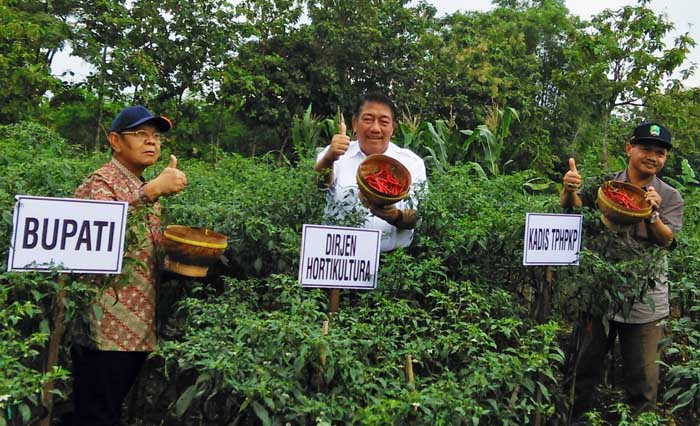Antisipasi Lonjakan Harga, Petani Diminta Jual 40% Produksi Cabai ke Bulog
Indonesian Farmers are Required to Sell 40% of Chili Harvest to Logistics Agency
Reporter : Gusmiati Waris
Editor : Cahyani Harzi
Translator : Dhelia Gani

Magetan, Jatim (B2B) - Kementerian Pertanian RI mendorong para petani cabai di daerah untuk menjual 40% produksinya kepada pemerintah pusat melalui Bulog untuk mendukung stabilisasi harga di tingkat konsumen, khususnya ketika harga cabai melambung tanpa kendali seperti yang terjadi saat ini, dan tim pengendali inflasi daerah (TPID) provinsi dan kabupaten/kota diharapkan berkoordinasi dengan pihak-pihak terkait untuk mengatasi lonjakan harga demi menekan inflasi.
Seruan tersebut dikemukakan Dirjen Hortikultura Spudnik Sujono pada Sabtu (11/2) di tengah hamparan perkebunan cabai 200 hektar milik petani Kecamatan Parang, Kabupaten Magetan, Provinsi Jawa Timur. Duduk di bagian tamu utama antara lain Bupati Sumantri, Dandim Magetan 081/DSJ Letkol Inf Herwin Rizayan dan Direktur Pengolahan dan Pemasaran Hasil Hortikultura, Sukarman.
"Petani harus untung, tapi juga mesti memikirkan kepentingan konsumen, dan pemerintah mengajak petani membantu pemerintah. Maksudnya, petani cabai memberikan 30 sampai 40 persen kepada pemerintah melalui Bulog. Minimal buat konsumen di sini, syukur bisa menyuplai sampai Jakarta, untuk membantu pemerintah pusat melakukan stabilisasi harga," kata Spudnik Sujono usai panen cabai di Kecamatan Parang.
Dia mengharapkan TPID di daerah dapat mendukung kinerja gubernur dan bupati/walikota untuk menekan inflasi, sehingga harga cabai di tingkat konsumen tetap terjangkau, dan pemerintah pusat memikirkan laju inflasi di daerah, dan kinerja Ditjen Hortikultura di Kementan turut ditentukan oleh inflasi di daerah.
"Kementan berupaya menjaga inflasi di tingkat konsumen, karena hal itu juga menentukan kinerja kami. Kami harapkan harga cabai di Magetan tidak semahal di luar kabupaten, karena ada TPID yang bertugas mengawal lonjakan inflasi. Tentu sangat ironis, apabila harga cabai di Magetan juga mahal padahal sejauh mata kita memandang, terbentang hamparan tanaman cabai," kata Spudnik.
Dirjen Hortikultura menyebut petani yang bersedia mendukung pemerintah sebagai 'petani merah putih' agar tidak melepas seluruh hasil panen kepada tengkulak, karena hal itu sama dengan 'membuang garam di laut' sehingga bantuan APBN untuk petani menjadi sia-sia. "Minimal saya minta Magetan dapat menyisihkan hampir separuh hasil panen untuk dijual kepada Bulog. Kalau harga cabai kembali stabil, silahkan jual kembali ke pasar bebas.
Membangun Embung
Dirjen Spudnik Sujono juga menyoroti lahan tadah hujan di sebagian besar lahan perkebunan cabai di Magetan yang mempengaruhi tingkat produksi, dan dia meminta dinas pertanian kabupaten melakukan koordinasi dengan Ditjen Prasarana dan Sarana Pertanian (PSP) untuk melakukan inventarisasi sebelum mengembangkan embung untuk mendukung lahan pengairan setempat, hal itu sesuai instruksi Presiden Joko Widodo kepada Mentan Andi Amran Sulaiman untuk mengembangkan embung sebagai penunjang pengairan untuk lahan pertanian.
"Lahan di sini tadah hujan. Sumber air cukup jauh dan pilihan memakai pompa air terkendala harus memompa terlalu dalam hingga 200 meter, dan sebaiknya memakai pola gravitasi tanpa harus menggunakan mesin karena lebih irit biayanya," kata Spudnik.
Kepala Bidang Hortikultura Dinas Pertanian Provinsi Jatim mendukung usulan Dirjen Hortikultura untuk menunjang luas panen cabai di seluruh Jatim yang mencapai 5.546 hektar bulan ini, 5.000 hektar siap panen pada Maret, begitu pula hingga April dan Mei dan hasil panen mulai menurun pada Juni mendatang.
"Hampir seluruh produksi cabai di Jatim mengalir ke luar provinsi khususnya Jakarta dan sekitarnya, dengan rata-rata produksi maksimal lima ton per hektar pada musim kemarau, sementara kebutuhan cabai di provinsi disuplai dari Madura, Tuban dan Lamongan," kata Retno Ningsih kepada B2B.
Petani cabai, Mustofa mengakui bahwa 152 hektar lahan perkebunan cabai di desanya, Desa Lopang hanya panen satu kali dalam setahun dengan sistem tumpang sari, "sebelumnya tanam kacang tanah, setelah panen kemudian ditanami cabai lalu jagung."
Spudnik Sujono menambahkan Kementan tahun ini aktif melakukan inventarisasi potensi pengembangan embung pada lahan pertanian di seluruh Indonesia, dan pemerintah pusat tidak dapat bertindak lebih jauh sesuai regulasi apabila tidak didukung oleh permintaan dari daerah. "Bukan lagi usulan dari atas, tapi harus bottom up, pemerintah tidak bisa bertindak lebih jauh tanpa usulan dari kelompok tani."
Magetan, East Java (B2B) - Indonesian Agriculture Ministry encourages chili farmers accross the country to
to sell 40% of production to the central government through the National Logistics Agency (Bulog) support price stability at the consumer level, when chili prices rises uncontrollably as it is today, and the team to control inflation (TPID) provincial and district/cities level are expected coordinate with relevant parties to suppress inflation, according to the senior official.
The remark was made by Director General of Horticulture Spudnik Sujono on Saturday (2.11.17) in middle stretch of chili plantation 200 hectares owned by chili farmers in Parang subdistrict of Magetan district in East Java province. Sat down as the main guests Regent Sumantri, Commander of Magetan's District Command Lt. Col. Herwin Rizayan and Director of Products Processing and Marketing of Horticulture, Sukarman.
"Farmers must make a profit, but also must think about benefit of consumers, and we invite farmers help the government. It means chili farmers provide 30 to 40 percent to the central government through the Bulog. At least for local consumers, even better supply to Jakarta, so it can support the central government to control chili prices," Mr Sujono said after chili harvest in Parang subdistrict.
He expects the team to control inflation in the region support performance of governor and regent/mayor to curb inflation, so that the chili prices remain affordable for consumers, and central government focus on inflation in region, and it determines performance of the Directorate General of Horticulture.
"The ministry seeks to rein in inflation at the consumer level, was also determines our performance. We expect chili prices in Magetan not as expensive outside the district, because there is a special team to tackle inflation. Sure is ironic, if chili prices in Magetan was also expensive," Mr Sujono said.
He mention chili farmers who agreed to support government as a 'model farmers' in order not to sell their chili harvest to middlemen, because it the same as 'throw salt in the ocean' so that the support of the national budget for farmers useless. "At least, I asked farmers in Magetan can sell almost half of their harvest to the Bulog."
Water Reservoir
Mr Sujono also highlights the rainfed on most of the land in Magetan affect production levels of chili, and he asks the department of agriculture to coordinate with Directorate General of Infrastructure and Facilities conduct an inventory before developing water reservoir for land irrigation, according to orders of President Joko Widodo to Agriculture Minister Andi Amran Sulaiman for developing water reservoir as a support for farmland irrigation.
"The land is rainfed. The water source far enough and choice of using water pumps constrained water resources too deep up to 200 meters, and should implement a system of gravity without having to use the machine to save costs," he said.
Head of the East Java Provincial Agriculture Office supported the proposal of Mr. Sujono for support of chili land across the province this month reached 5,546 hectares, 5,000 hectares ready for harvest in March, as well until April and May, and of chili harvest decreased in June.
"Almost the entire production of chili in East Java sold outside the province, particularly in Jakarta and surrounding areas, with an average production up to five tons per hectare during the dry season, while needs of chili in the province is supplied from Madura, Tuban and Lamongan," Mrs Ningsih told the press.
Chili farmer, Mustafa admitted that 152 hectares of chili in his village, Lopang village only harvested once a year in intercropping systems, "before it we planted peanuts, and chili and then planting corn."
Mr. Sujono added that this year the ministry active take inventory of of potential water reservoir development on agricultural land across the coutry, and the central government unable to act if it does not supported by demand from the region. "It's no longer a proposal from above, but must be bottom up, government prohibited acts without a proposal from farmer groups."















